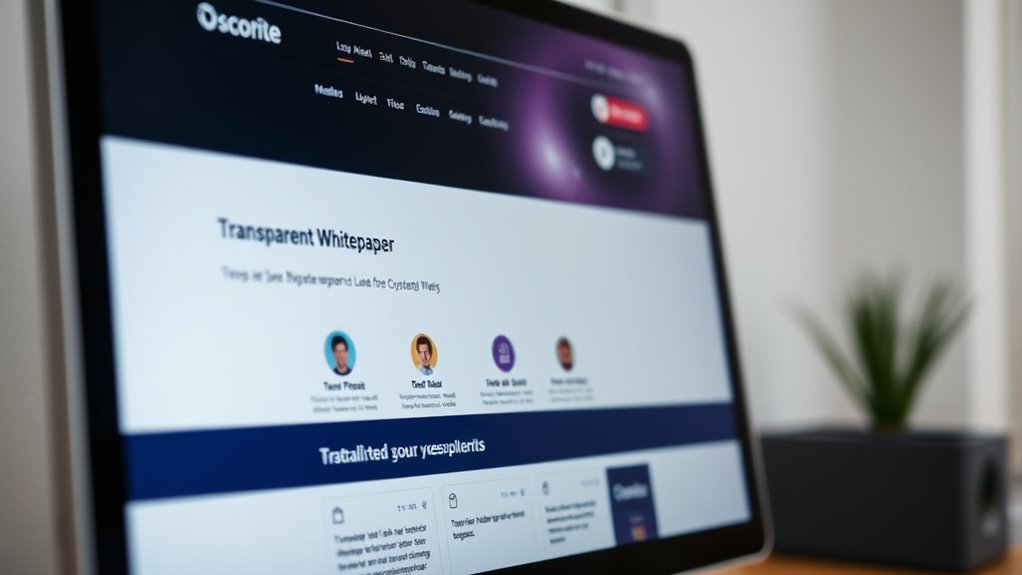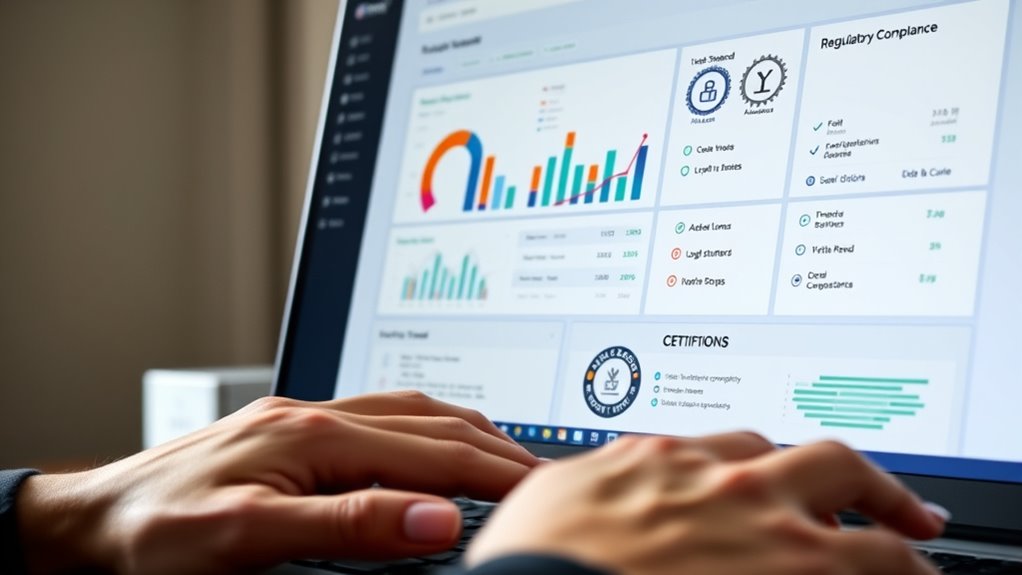To determine if a crypto project is legit before investing, start by verifying the team’s backgrounds on platforms like LinkedIn and check for their experience. Look for official partnerships and community feedback from reputable sources. Examine the white paper for clear, realistic goals, and assess the website for professionalism. Confirm security audits from trusted firms and ensure the project complies with relevant regulations. If you continue exploring, you’ll uncover even more ways to stay safe.
Key Takeaways
- Verify team credentials and transparency through LinkedIn profiles and public appearances.
- Confirm official partnerships via reputable sources and community feedback.
- Assess website professionalism, content quality, and active community engagement.
- Review white paper, tokenomics, and security audits for clarity, feasibility, and safety.
- Ensure regulatory compliance and proper source verification to mitigate legal and security risks.
Verify the Team’s Background and Credibility

To verify a crypto project’s team, start by checking the professional backgrounds and identities of its members on platforms like LinkedIn or similar sites. Look for detailed profiles that show relevant experience in blockchain, finance, or software development. If team members are anonymous or lack verifiable credentials, that’s a red flag. Legitimate projects openly disclose core team members, advisors, and contributors, so check for clear, publicly available information. Also, investigate their public appearances, interviews, or community involvement to gauge authenticity. Be cautious if there’s negative feedback or previous controversies linked to them. A transparent team with verifiable backgrounds and active industry presence indicates higher credibility and reduces investment risks. Additionally, assessing their transparency practices can help determine how committed they are to building trust with investors.
Assess Transparency and Public Presence of the Team

How transparent a team is can reveal a lot about a project’s legitimacy. You should look for clear signs of openness.
Team transparency signals project legitimacy and builds investor trust.
- Visualize team members’ profiles on LinkedIn or similar platforms showing relevant experience in blockchain, finance, or software development.
- Imagine a project that openly discloses core developers, advisors, and contributors on their website or in official channels.
- Envision the team actively participating in interviews, AMAs, or blockchain communities, demonstrating authenticity.
- Recognize that ongoing transparency and engagement help build trust and accountability essential for a project’s credibility.
If you find anonymous or hidden team members, or if there’s little public presence, be cautious. Transparency and active engagement indicate a genuine project that values accountability and investor trust.
Confirm Official Partnerships and Collaborations

Verifying official partnerships is essential because they serve as a strong indicator of a project’s credibility. To do this, check announcements on both the project’s and partner’s websites or press releases. Genuine collaborations appear on reputable news sources and official channels. Reputable partnerships often involve well-known industry players, adding trustworthiness. Be cautious of unverified claims or vague references. Additionally, reviewing the yoga practices and techniques involved in a project can provide insights into its legitimacy and focus.
Analyze the White Paper for Clarity and Realism

When reviewing a white paper, it’s crucial to assess whether the document presents clear, realistic objectives and detailed technical explanations. A well-crafted white paper should outline the project’s goals, technology, and token utility without ambiguity. Look for a document that:
- Provides specific technical details—like how the blockchain operates or security measures—so you understand the mechanics.
- Includes a coherent roadmap showing achievable milestones, not vague promises.
- Avoids overly complex jargon or plagiarized sections that could indicate superficial effort or dishonesty.
- Demonstrates consistency with established industry standards and best practices, ensuring the project aligns with recognized blockchain principles.
A professional white paper is error-free and accessible via the official website. If the document is vague, inconsistent, or filled with errors, it’s a red flag for potential scam or unprofessionalism.
Evaluate the Professionalism of the Website and Content

A professional website is often the first indicator of a legitimate crypto project, so it’s *essential* to scrutinize its design and content carefully. Look for a clean, well-organized layout free of broken links and outdated information. Check that the language is clear, concise, and free of spelling or grammatical errors—sloppy writing can signal a lack of professionalism. Verify that all key sections, such as the white paper, team info, and roadmap, are accessible and up-to-date. Authentic projects typically provide detailed explanations of their technology and token utility. Be wary of sites with vague descriptions, excessive technical jargon, or plagiarized content. A polished, transparent website demonstrates effort, credibility, and a serious approach, helping you differentiate genuine projects from scams. Additionally, content quality and topical authority are crucial factors that can signal the project’s commitment to transparency and expertise.
Examine Community Engagement and Social Media Activity

You should check how active the project’s social media platforms and community channels are, as consistent updates indicate ongoing development. Look beyond follower counts to see if interactions are genuine, meaningful, and responsive, not just bot activity. Pay attention to community sentiment trends, including both praise and criticism, to gauge overall trust and engagement. Additionally, observing self-awareness within community discussions can provide insights into the project’s transparency and integrity.
Platform Activity Levels
Evaluating a project’s platform activity involves examining its community engagement and social media presence to gauge ongoing development and user trust. You want to see consistent updates, active discussions, and responsiveness from the team.
Consider these key indicators:
- Frequent posts on platforms like Twitter, Reddit, or Telegram, showing ongoing communication.
- Meaningful interactions—comments, questions, and feedback—are addressed rather than ignored.
- Community members engaging in debates, sharing insights, and providing constructive criticism, indicating a lively ecosystem.
- Monitoring platform activity levels can help identify if the project maintains sustained effort and transparency over time.
A project with vibrant activity suggests transparency and dedication, while stagnant or overly controlled discussions may signal issues. Look for genuine involvement over mere follower counts to assess the project’s real engagement level.
Interaction Quality and Depth
Community engagement and social media activity reveal much about a project’s transparency and significance. You should look beyond follower counts and focus on how active the community truly is. Are members asking questions, sharing ideas, and receiving timely responses? Genuine projects foster meaningful conversations and show responsiveness from team members. Be wary of accounts with bot-like comments or a flood of generic messages that lack substance. Check if critiques and negative feedback are acknowledged rather than censored; transparent projects accept constructive criticism. Explore platforms like Twitter, Discord, Reddit, and Telegram for signs of ongoing development updates and community trust. Active, passionate members who engage regularly indicate a healthy, committed community, which often correlates with a project’s long-term viability and credibility. Monitoring community moderation can also provide insight into how well a project manages transparency and fosters trust among its supporters.
Community Sentiment Trends
How can you gauge the true health of a crypto project’s community? You need to look beyond follower counts and check how people interact. Pay attention to social media activity and engagement quality. Consider these key indicators:
- Consistent Updates: Are there regular, meaningful posts and replies, or is activity sporadic?
- Authentic Conversations: Do community members ask questions, share feedback, and receive responses, or are comments mostly generic or automated?
- Balanced Feedback: Is criticism acknowledged and addressed, or are negative comments censored or ignored?
- Community Involvement in Organizational Decisions: Are community members engaged in decision-making processes or governance, indicating a transparent and participatory environment?
A thriving community shows lively debates, transparent communication, and constructive criticism. If the community feels engaged and responsive, it’s a good sign that the project has ongoing support and genuine interest.
Review Tokenomics and Conduct Basic Audit Checks

Start by reviewing how the project distributes its tokens to guarantee fairness and transparency, paying attention to the methods used. Next, assess the total supply, inflation mechanisms, and how tokens are allocated over time to gauge long-term sustainability. Additionally, consider the importance of tokenomics in understanding the project’s economic model and potential profitability. Finally, verify the credibility of any audits conducted by reputable security firms, and consider their findings in your overall evaluation.
Analyze Token Distribution Methods
Reviewing token distribution methods is essential because it reveals how a project allocates its tokens and whether the process is fair and sustainable. You want to see a clear plan that avoids excessive early allocations to team members or insiders, which could lead to pump-and-dump schemes. Look for transparency about the distribution timeline and vesting schedules.
Consider these key points:
- Visualize tokens evenly spread across founders, team, advisors, and community, preventing concentration risks.
- Imagine a gradual release schedule that aligns with project milestones, reducing the chance of sudden market dumps.
- Think about lock-in periods for team and early investors, ensuring long-term commitment and project stability.
A transparent, balanced distribution signals a healthier, more reliable project.
Assess Supply and Inflation
Understanding a project’s tokenomics is essential because it reveals how tokens are distributed, used, and managed over time. You should review the total supply, circulating supply, and inflation mechanisms to gauge sustainability. Check if the token has a fixed cap or if new tokens are minted continuously, which could lead to inflation and devalue holdings. Also, examine how tokens are allocated among founders, investors, and the community—overly concentrated ownership raises red flags. Look into any scheduled token releases or lock-up periods that prevent sudden dumps. Additionally, verify whether inflation or deflation features are built-in to maintain value. These insights help you assess whether the project’s economic model supports long-term growth or risks devaluation due to unchecked supply increases.
Verify Audit Credibility
Evaluating a project’s credibility requires more than just examining its tokenomics; it also involves appraising the quality and scope of its audit reports. First, verify that the audit comes from a reputable cybersecurity firm with experience in crypto security, ensuring thorough vulnerability detection. Second, review the audit’s findings—look for clear reports that detail tested areas, vulnerabilities found, and how they were addressed, indicating transparency. Third, consider the scope of the audit: does it cover smart contracts, tokenomics, and network infrastructure? A thorough audit provides confidence, while superficial reports may hide risks. Remember, audits are only part of the picture—combine them with team credibility, project transparency, and community trust for a complete assessment.
Check for Regulatory Compliance and Legal Standing

Regulatory compliance is a key indicator of a crypto project’s legitimacy and long-term viability. You should check if the project adheres to relevant KYC and AML regulations in its jurisdiction, as this illustrates a commitment to legal standards. Verify whether the platform uses reputable identity verification solutions to guarantee secure and efficient onboarding. Projects that ignore or bypass legal requirements pose higher risks of fraud, shutdown, or legal action. Look for signs of ongoing regulatory oversight, such as licensing or registration with financial authorities. Additionally, review publicly available documents to confirm compliance status. A project that actively aligns with legal frameworks signals transparency and a lower likelihood of future legal issues, making it a safer choice for your investment.
Investigate Past Controversies or Red Flags

Investigating past controversies or red flags can reveal warning signs that might not be immediately obvious through official documents or community feedback. These issues often point to deeper problems or previous misconduct that could threaten the project’s legitimacy.
- Legal troubles or lawsuits: Search for any past legal cases involving the team or project, especially those related to fraud or misrepresentation, which can signal serious risks.
- Scandals or misconduct: Look for reports of scams, misappropriation of funds, or unethical behavior tied to the project or its members.
- Unresolved red flags: Identify past red flags like failed projects, sudden disappearances, or suspicious funding, which may re-emerge and jeopardize your investment.
Uncovering these warning signs helps you avoid projects with a troubling history.
Cross-Reference Information With Reputable Sources

Always verify official announcements by checking the project’s website and social media channels. Then, consult reputable industry news sources to see if they report on the project’s developments or any red flags. Finally, cross-check claimed partnerships and endorsements with independent sources to confirm their authenticity.
Verify Official Announcements
To verify official announcements, you need to cross-check the information with reputable sources such as the project’s official website, verified social media accounts, and trusted news outlets. This helps guarantee the news isn’t fabricated or misleading.
- Visit the project’s official channels and look for consistency in updates, press releases, and announcements.
- Check verified social media accounts for recent activity and confirm they match official statements.
- Cross-reference announcements with reputable news sites or industry publications to confirm their legitimacy.
Consult Industry News Sources
How can you guarantee that the information a crypto project shares is accurate and trustworthy? By consulting industry news sources, you cross-reference claims with reputable outlets, press releases, and analyst reports. This helps verify project milestones, partnerships, or leadership updates, reducing reliance on potentially biased or false info. Be cautious of conflicting reports or sensational headlines; always prioritize well-known, established platforms. Remember, reputable news sources often provide detailed analysis and context that can uncover red flags others might miss. Use the table below to compare information across sources:
| Source Type | What to Look For |
|---|---|
| Mainstream Media | Confirm announcements, partnerships, and leadership |
| Crypto News Outlets | Check for analysis, community feedback, and red flags |
| Official Channels | Verify consistency with project claims |
| Community Forums | Note discrepancies or negative sentiment |
Relying on diverse, trustworthy sources strengthens your due diligence.
Cross-Check Partner Endorsements
Are the partner endorsements claimed by the project genuinely credible? To verify, you need to cross-reference these claims with reputable sources. Imagine, for example:
- Visiting the official websites of supposed partner companies and checking their press or news sections for announcements about the collaboration.
- Searching for news articles or industry press coverage confirming the partnership, avoiding suspicious or unverified blogs.
- Examining the credibility and background of the partner organizations or advisors linked to the project, ensuring they are established and recognized within the industry.
Frequently Asked Questions
How Can I Verify the Authenticity of a Project’s Team Members?
You can verify a project’s team members by checking their LinkedIn profiles or other professional platforms to confirm their experience in blockchain, finance, or software development. Look for clear identification, their past projects, and public appearances. Avoid anonymous teams or those with incomplete profiles. Research any controversies or negative feedback linked to them. Genuine teams are transparent about their backgrounds and actively engage in community events, which adds to their credibility.
What Indicators Suggest a Project’s White Paper May Be Plagiarized?
You can spot a plagiarized white paper by checking for inconsistent writing styles, repetitive phrases, or sections that seem copied from other sources. Look for vague or overly generic content that lacks specific technical details. Run the document through plagiarism detectors or compare key sections with known white papers online. If you notice poorly written, error-filled, or mismatched language, it’s a red flag indicating the white paper might be copied or not genuine.
How Do I Identify Fake or Misleading Partnership Claims?
You can spot fake partnership claims by verifying announcements on official partner websites or trusted news sources. Reputable partnerships appear on both parties’ channels, not just the project’s. Cross-check the partnership details with the partner’s official communications. Be wary of claims that lack independent confirmation or seem exaggerated. Genuine collaborations usually have verifiable press releases, logos, or joint projects that demonstrate real, transparent relationships.
What Community Signals Indicate a Trustworthy Crypto Project?
Did you know that over 60% of successful crypto projects have active, engaged communities? To spot trustworthy projects, look for consistent updates on platforms like Twitter, Discord, or Reddit. Genuine projects foster meaningful conversations and respond to questions openly. Avoid communities that censor criticism or ban dissenters. An active, transparent community with diverse feedback indicates ongoing development and trust, so invest your time observing how the project maintains honest engagement with its followers.
How Reliable Are Third-Party Audits in Assessing Project Legitimacy?
Third-party audits are useful but not foolproof in evaluating a project’s legitimacy. They provide an independent review of security and code quality, which helps identify vulnerabilities. However, audits can have scope limitations, and not all findings are equally reliable. You should consider audits alongside other factors like team transparency, community trust, and regulatory compliance. Relying solely on audits might give false confidence; always do extensive research before investing.
Conclusion
Think of vetting a crypto project like steering a river’s currents—you need clear maps, trusted guides, and steady landmarks to avoid treacherous waters. By checking their team, transparency, partnerships, and legal standing, you’re charting a course through potential storms. With careful research, you become the captain of your financial ship, steering confidently toward safe harbors. Remember, a well-verified project is your compass in the vast, unpredictable crypto ocean.








